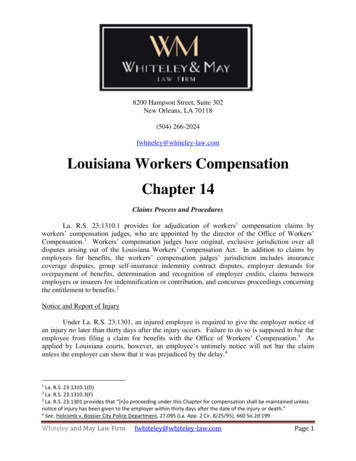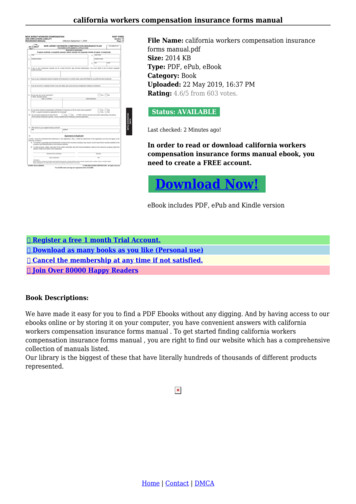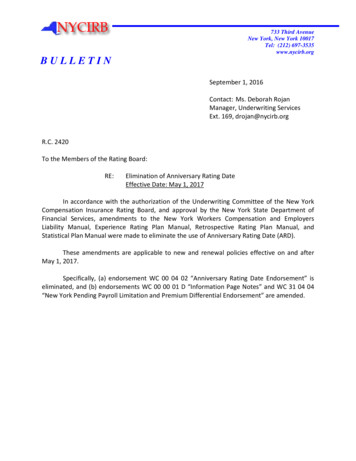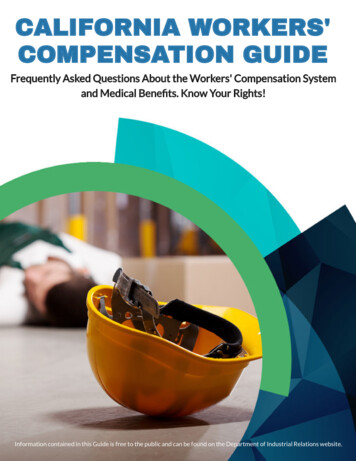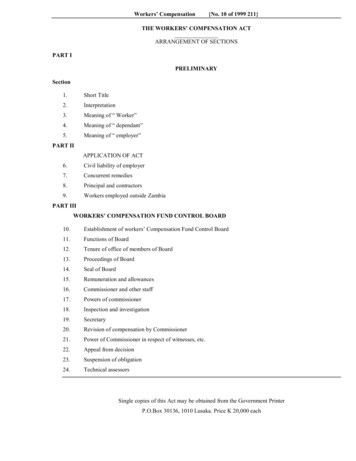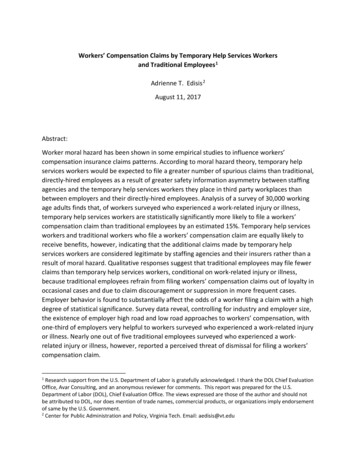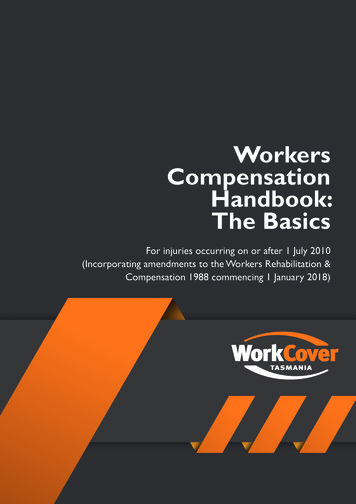
Transcription
WorkersCompensationHandbook:The BasicsFor injuries occurring on or after 1 July 2010(Incorporating amendments to the Workers Rehabilitation &Compensation 1988 commencing 1 January 2018)
Please noteThis information is for guidance only and is not to be taken as an expression of the law. Itshould be read in conjunction with the Workers Rehabilitation and Compensation Act 1988,the Workers Rehabilitation and Compensation Regulations 2011 and any other relevantlegislation. You can find these atwww.worksafe.tas.gov.auThis guide was produced by staff from WorkSafe Tasmania.We welcome your feedback on this guide. Send to: wstinfo@justice.tas.gov.au2
ContentsIntroduction. 4Making a claim for compensation. 7Injury management. 9Compensation payments.11Common law damages.18Dispute resolution.19Further information.20Workers Compensation Handbook: The Basics3
IntroductionWhat is workers compensation?Workers compensation is compensation payable under the Workers Rehabilitation and Compensation Act 1988to a worker who suffers an injury or disease arising out of or in the course of their employment. For a disease,the worker’s employment must have contributed to it to a substantial degree.A worker may be entitled to compensation for: weekly payments while incapacitated for work medical and other expenses rehabilitation expenses permanent impairment.In some circumstances, a worker may also be able to make a common law damages claim.The legislationThe main law for workers compensation in Tasmania is the Workers Rehabilitation and Compensation Act 1988.This Act has two main purposes: to return an injured or sick worker to work as quickly and safely as possible to ensure an injured or sick worker is compensated for lost wages, medical and other expenses whilethey are unable to work, and that the dependants of a deceased worker are compensated.The Act is supported by the Workers Rehabilitation and Compensation Regulations 2011.You can find the Act and the Regulations at www.worksafe.tas.gov.auWorkers compensation insuranceAn employer must either: take out a workers compensation insurance policy with a licensed insurer to cover it for workerscompensation claims made by its workers, or apply to the WorkCover Tasmania Board and be granted a permit to self-insure against workerscompensation claims made by its workers.4
Who is entitled to claim workers compensation?Definition of ‘worker’To be entitled to compensation, a person must be a worker. A worker is someone who works under a contractof service or a training agreement. This includes casual employment. A contract does not necessarily have to bea formal, written document — it could be implied and/or a verbal agreement.Deemed workersSome people are ‘deemed’ to be workers under the Act. They are: volunteer police, fire-fighters, ambulance workers and other prescribed volunteers while they areengaged in their volunteer duties taxi drivers and luxury hire care drivers while they are driving or performing any associated activity,such as loading, unloading or cleaning the vehicle (except where the driver is the responsible operatorof the taxi or licensee of the luxury hire car) jockeys and apprentice jockeys while they are: engaged to ride a horse for reward at a race meeting or official trial held in Tasmania under the Rulesof Racing, or engaged to ride a thoroughbred horse in a training session in Tasmania conducted by a licensed traineror delegate salespeople, canvassers and collectors paid by commission.Although not specifically deemed to be workers under the Act, working directors have generally beendetermined by the courts to be workers. A working director is a director of the company whose earnings as adirector are for personal labour or services.People who are not workersSome people are specifically excluded from the Act. They are not entitled to workers compensation if injuredwhile working. These excluded people are: people employed on a casual basis for a purpose other than the employer’s trade or business outworkers people employed as domestic servants with a private family, who have done less than 48 hoursemployment with their employer when they are injured (people in casual domestic employment, suchas cleaners, would usually be covered by an extension of a household insurance policy) crew members of a fishing boat who are paid wholly or mainly on the basis of a share of the profits orgross earnings of the boat people taking part in approved programs of work for unemployment payment (work-for-the-doleschemes) people employed on ships covered by the Commonwealth Seafarers Rehabilitation and CompensationAct 1992.SportspeopleIn general, the Act does not apply to people engaged in sporting activities who receive payment simply forplaying, training or travelling with a sporting body.However, if someone is engaged under a contract of service with a sporting body (for example, as a paid coach,umpire or referee), they are a worker.The Act also covers sportspeople who are paid under a contract of service to perform tasks not related tocompetition.Workers Compensation Handbook: The Basics5
When is a worker entitled to compensation?A worker is entitled to workers compensation if they suffer an injury or disease that arises out of or in thecourse of their employment or to which their employment has contributed to a substantial degree.However, injuries suffered in the following situations are specifically excluded: any injury that occurs while a worker is travelling between their home and work (unless the injuryoccurs during a deviation from their normal route that their employer tells, asks or authorises them tomake) any injury that occurs during an absence from the workplace that was not authorised, directed orrequested by their employer any injury that is caused by a worker’s serious or wilful misconduct (unless the injury results in theirdeath, or serious and permanent incapacity) any injury that was intentionally self-inflicted.DiseaseA worker is entitled to compensation for a disease that their employment contributed to by a substantialdegree. That is, their work must be the major or most significant factor in their disease.Some injuries and diseases are contracted by a gradual process, or may not become apparent until some timeafter initial exposure or contraction.Industrial deafnessIndustrial deafness is the permanent loss of hearing caused by a worker being exposed to industrial noise intheir employment.A worker is entitled to workers compensation for industrial deafness which occurred after 16 August 1995.They must have suffered more than 5% binaural hearing impairment due to industrial deafness since 16 August1995.6
Making a claim for compensationNotice of injuryThe worker must tell their employer as soon as possible after suffering a workplace injury or disease, andbefore voluntarily leaving the employment that the injury occurred in. They can do this verbally or in writing.In the case of industrial deafness, the worker must tell their employer within 6 months of ending theiremployment.Within 14 days of receiving this notification, the employer must inform the worker of their right to make aclaim for compensation by giving them a notice in the form prescribed in the Regulations.Go to www.worksafe.tas.gov.au and search for ‘GF172’.If a worker wishes to make a workers compensation claim and asks for a worker’s claim for compensation form,an employer must supply it and must not obstruct the worker.What is required to claim compensation?A workers compensation claim consists of: a worker’s claim for compensation form: obtained from the employer (or in certain circumstances,from the insurer or WorkCover Tasmania) a workers compensation medical certificate obtained from and signed by a medical practitioner.The worker must give these to their employer by: taking them to their employer (or a person designated by the employer) in person, or posting them to their employer’s usual or last known place of business.The employer must then tell their insurer within 3 working days that they have received the claim, andcomplete the employers report section of the claim form and forward it to their insurer within 5 working days.Time limits for making a claimIn most cases, the worker must make their claim within 6 months of the date of their injury.However, it is recognised that it may be difficult to determine a date for industrial deafness and some gradualonset diseases. In these cases, the timeframes for making a claim are: for industrial deafness: the worker must make their claim while still in the employment of theresponsible employer or within 6 months of leaving for a disease: the worker must make their claim within 6 months of the day that the worker firstbecomes incapacitated by the disease. If that date can’t be determined, then the worker must lodgetheir claim within 6 months of the day a medical practitioner certifies that the worker was firstincapacitated.Failing to make a claim within these timeframes will not make a worker’s claim invalid if the failure was due tomistake, the worker’s absence from Tasmania, or other reasonable cause.A reasonable cause could include: the employer making a payment to the worker that they believe is a payment of compensation the employer telling the worker that compensation will (or will not) be payable the employer failing to provide the Notice of Right to Make a Workers Compensation Claim (seeNotice of injury above).Starting weekly payments and paying medical expensesOnce they receive the worker’s claim for compensation, the employer must:Workers Compensation Handbook: The Basics7
start making weekly payments of compensation if the worker has been certified as totally or partiallyincapacitated for work start paying for medical and associated expenses up to 5,000, unless they think the claimed expensesare unreasonable or unnecessary (see Accepting or disputing liability for claim below).These payments are to start regardless of whether the employer disputes liability for the worker’s claim. Theyare sometimes called ‘without prejudice payments’, because the fact the employer makes these payments cannotbe used against them as an admission of liability.Notice of status of claimThe employer or their insurer must give the worker written notice of the status of their claim within 28 daysof receiving it. If a decision has not been what whether to accept or dispute a claim at this stage, the workermust be advised of the reasons why the decision has not been made and what steps are being taken to progressmaking a decision.Accepting or disputing liability for claimThe employer has 84 days to dispute liability to pay compensation.If the employer does not dispute liability within 84 days, it is taken that they have accepted liability for the claim,and the Tribunal can order the employer to pay compensation.If the employer does dispute liability, then they must (within 84 days): serve a notice on the worker stating that the employer disputes liability to pay weekly payments ormedical and other expenses (or both) inform the worker of the reasons for disputing liability refer the matter to the Workers Rehabilitation and Compensation Tribunal (Tribunal).Claims by dependants of deceased workersIf a worker has died from a work-related injury or disease, their dependants may be entitled to compensation. Aclaim by a dependant must be: made within 6 months of the date of the deceased worker’s death made using the ‘Claim form for Dependants of Deceased Workers’. Go to www.worksafe.tas.gov.au andsearch for ‘dependants’ delivered to the employer (or a person designated by the employer).8
Injury managementWhat is injury management?Injury management is the process of managing an injured worker, to provide them with a timely, safe anddurable return to work.Injury management should start as soon as possible following an injury, because this improves the worker’schances of recovering from the injury and safely returning to work.The Act reinforces this by having injury management provisions apply even where there is a dispute about theemployer’s liability for the claim.Employers and insurers must have an approved injury management program in place (insurers must make sureeach of their clients has one, too). This fosters employer and insurer commitment to injury management beforeany injuries occur.An injury management program is a program approved by the Board which outlines the method an insurer willapply to manage claims.For more information about injury management, go to www.worksafe.tas.gov.auKey rolesAside from the worker, the employer and the insurer, there are some other important people: the worker’s primary treating medical practitioner the injury management co-ordinator, who co-ordinates and oversees the entire injury managementprocess for serious workplace injuries, and provides a single contact for everyone the return to work co-ordinator (for workplaces with over 100 employees), who provides support andassistance to injured workers at their workplace the workplace rehabilitation provider, who provides specific services known as ‘workplacerehabilitation services’. These can include assessing the functional capacity of a worker, rehabilitationcounselling, and advice about job modification.For more information about these roles, go to www.worksafe.tas.gov.auThe medical certificateTo ensure the worker’s injury is regularly reviewed and return to work measures can be put into place, amedical practitioner is not to certify total incapacity for more than 28 days, unless they provide reasons for alonger period and a review date on the certificate.In some circumstances, the medical practitioner may think the worker is unlikely to be able to return to theirpre-injury hours or duties for a specified period, or ever. In this case, the medical practitioner must specify thisopinion and the reasons for it on the medical certificate.Full disclosure of informationThe worker must tell their doctor (and any other treating medical practitioner) any information that is relevantto the diagnosis or treatment of the worker’s injury. This will help the doctor make accurate diagnoses andappropriate decisions about treatment and injury management.Return to work plans and injury management plansWhere a worker suffers a significant injury (more than 5 working days of either partial or total incapacity forwork), the insurer/employer must appoint an injury management co-ordinator who is responsible for ensuringthere is a plan for co-ordinating and managing the worker’s treatment, rehabilitation and return to work.There are two types of plans for managing a significant workplace injury: return to work plans and injuryWorkers Compensation Handbook: The Basics9
management plans. The type of plan used depends on the time a worker is (or is likely to be) incapacitated forwork.A return to work plan is a simple plan for managing a worker’s injury or condition. It details the agreedactions, goals and assistance required to support the worker to remain at work or return to their pre-injuryemployment.An injury management plan is a more comprehensive plan than a return to work plan. It provides details ontreatment and rehabilitation as well as strategies to help the injured worker return to work.The worker and the worker’s employer should both agree to the content of return to work and injurymanagement plans. It is also important to ensure that the worker’s primary treating medical practitioner hasseen and given consent to the plans. Plans need to be consistent with the medical condition and complementtreatment.Plans must be developed and implemented in accordance with the time frames and requirements of theinsurer’s or employer’s injury management program approved by the WorkCover Tasmania Board.Keeping the worker’s job openThe employer must keep the injured worker’s job available for them to return to for 12 months, unless: there is medical evidence that it is highly unlikely the worker will be able to do their pre-injury job, or their pre-injury job is no longer required.If the employer decides to terminate a worker’s employment for either of these reasons, they must tell theworker and their insurer in writing of the reasons.Terminating a worker’s employment does not necessarily mean the employer’s obligations to the worker forinjury management and compensation cease.The employer must also bear in mind any relevant industrial relations law relating to termination ofemployment.Suitable alternative dutiesWhere a worker cannot return to their pre-injury job, the employer must provide suitable alternative duties.These are duties that an injured worker is suited to, taking into account the nature of the worker’s incapacityand their pre-injury employment and skills. They must not be demeaning or token duties.The employer must consult with the worker and the treating medical practitioner to decide what alternativeduties to give the worker.The employer must ensure these alternative duties take into account medical advice or restrictions on what theworker can do, and fit in with the worker’s return to work plan or injury management plan.If it is unreasonable or impracticable for the employer to provide suitable alternative duties, they must providethe worker with reasons for this in writing.Disputes about injury managementIf there is a dispute over injury management, the employer must inform the worker’s injury management coordinator, who must try to resolve the dispute through informal mediation.If the dispute is not resolved this way, then any of the parties can refer it to the Workers Rehabilitation andCompensation Tribunal.10
Compensation paymentsWhat are compensation payments?Compensation payments are paid to an injured worker on a ‘no fault basis’: that is, it is not necessary to proveanyone was at fault for causing the worker’s injury or disease.As long as the requirements of the Act are met, the worker is entitled to benefits. This is different fromcommon law damages, where the worker must prove that negligence on the part of another person (usually theemployer) resulted in or contributed to their injury.Weekly paymentsA worker who is incapacitated (either totally or partially) for work as a result of a work-related injury ordisease is entitled to weekly payments.Starting weekly paymentsOnce the employer receives the worker’s claim for compensation (involving incapacity for work), they muststart making weekly payments. There are two options for this: where the worker’s first pay day is within 14 days of lodging their claim, weekly payments must start onthis pay day (if it is not reasonably practicable to do this, payment must be made no later than 14 daysafter the employer received the claim), or where the worker’s first pay day is more than 14 days after lodging their claim, weekly payments muststart on this pay day (this usually happens where workers are paid monthly).If the worker lodged their claim: within 14 days of their injury, weekly payments must be paid from the date of injury more than 14 days after their injury, they are only entitled to be back paid weekly payments to 14 daysbefore the date they lodged their claim.Weekly payments should be paid on the worker’s usual pay day, unless the worker and employer have agreed (inwriting) to alternative arrangements.Calculating weekly paymentsThe worker is entitled to weekly payments at the highest amount of these two options: the worker’s ordinary time rate of pay for the employment (as set by an Award or other industrialinstrument such as an Enterprise Agreement) that the worker was engaged in immediately before theincapacity began, or the normal weekly earnings of the worker averaged over the relevant period of employment.The ‘relevant period’ depends on how long the worker has been employed by the employer: if continuously employed by the same employer for 12 months or more, the relevant period is the 12month period immediately before they were injured, or if continuously employed by the same employer for less than 12 months, the relevant period is theperiod the worker was employed by the employer immediately before they were injured.If the worker was employed by the employer for 14 days or less before the incapacity, the worker’s normalweekly earnings are taken to be the normal weekly earnings of another worker performing comparable work (ifthere is no other worker, it would be the worker’s expected weekly earnings).Normal weekly earnings include any regular allowances, but not travel or accommodation allowances. Overtimeis excluded other than in specified circumstances.Calculating weekly payments where a worker has more than one jobIf the worker had more than one job before being injured, the normal weekly earnings are calculated by addingWorkers Compensation Handbook: The Basics11
together their average weekly earnings from each job they were working in immediately before their injury.However, if one of the worker’s jobs was a full-time job, the normal weekly earnings are calculated by referringto this full-time job only.Step-downs in weekly paymentsFor the first 26 weeks of incapacity, the worker receives weekly payments at 100% of their normal weeklyearnings.After these 26 weeks, there are two reductions (or ‘step-downs’) in weekly payments: if the worker is incapacitated for more than 26 weeks, weekly payments are paid at 90% of theirnormal weekly earnings. However, if the worker is able to return to some form of work, but theiremployer is unwilling or unable to provide suitable alternative duties, then the worker will receive 95%of normal weekly earnings if the worker’s incapacity exceeds 78 weeks, weekly payments are reduced to 80%. However, if theworker is able to return to some form of work, but their employer is unwilling or unable to providesuitable alternative duties, then the worker will receive 85% of normal weekly earnings.The step-downs do not apply (that is, the worker will continue to be paid 100% of normal weekly earnings) ifthe worker is back at work for 50% or more of their normal weekly hours.If the worker is back at work for less than 50% of their normal weekly hours, then the step-down only appliesto the difference between what they are earning for the duties they are performing and their normal weeklyearnings.Low income workersThere is a ‘safety net’ to ensure low-earning workers do not experience an unsustainable loss of income as aresult of the step-downs.These workers are not to receive less than 70% of the basic salary or 100% of their normal weekly earnings,whichever is lower.For example, apprentices whose normal weekly earnings/ordinary time rate of pay are less than 70% of thebasic salary will continue to receive weekly payments at 100% of normal weekly earnings/ordinary time rate ofpay.To find out the current basic salary rate, go to www.worksafe.tas.gov.au and search for ‘basic salary rate’.Maximum period of entitlementThe maximum period that weekly payments can be paid depends on the worker’s level of whole personimpairment (WPI): a worker a workeryears a workeryears a workerwith a WPI of less than 15% is entitled to weekly payments for up to nine yearswith a WPI of at least 15% but less than 20% is entitled to weekly payments for up to 12with a WPI of at least 20% but less than 30% is entitled to weekly payments for up to 20with a WPI of 30% is entitled to weekly payments until the worker reaches the pension age.The end of weekly paymentsA worker is no longer entitled to weekly payments once they attain the pension age. The pension age meansthe age defined by the Social Security Act 1991 of the Commonwealth.This age restriction overrides the maximum periods of entitlement referred to above. For example, a workerwho is 60 years of age at the time of incapacity with a WPI of 15% will receive weekly payments until they attainthe pension age.12
There are two exceptions: if a worker is injured in the 12 months before the date on which they reach the pension age theirentitlements cease when they reach the pension age. If the worker’s injury occurs less than 12 monthsbefore the date on which the worker attains the pension age payments will cease one year after theinjury occurs. if a worker’s terms and conditions of employment allow them to work beyond the pension age, theworker can apply to the Tribunal to have their weekly payments extended beyond the pension age.Ending weekly payments under section 86Section 86(1) of the Act enables an employer to reduce or end weekly payments where:1/ the weekly payments the worker receives relate to total incapacity and the worker has returned to work2/ the worker is receiving weekly payments for partial incapacity and is earning more than their normal weeklyearnings or ordinary time rate of pay3/ a medical practitioner has examined the worker and certified in writing that in their opinion the worker haswholly or substantially recovered from the effects of the injury, or that the incapacity is no longer wholly orsubstantially due to the work-related injury4/ the worker’s entitlement to weekly payments has expired.If the reason for reducing or ending weekly payments is either 3 or 4, the employer must tell the worker (inwriting): that they intend to reduce or end the weekly payments that the worker has the right to refer the matter to the Tribunal, within 60 days of the date theirweekly payments were stopped or reduced.Weekly payments will end or be reduced 10 days after this written notice.The Tribunal has specific forms for referral of disputes. Call the Tribunal on (03) 6166 4750.Medical and other expensesThe employer is liable for the cost of all reasonable expenses the worker necessarily incurs for: medical services hospital services household services, for the proper running and maintenance of the worker’s home (such as cleaning,laundry and gardening) nursing services constant attendant services, including the constant or regular personal attendance on the workerprovided by someone who is not a member of the worker’s family (for example, to shower, dress orfeed the worker) rehabilitation services ambulance services.The employer is also liable to pay reasonable expenses for the worker to travel to any medical, hospital orrehabilitation service or to attend any medical examination organised by the employer.The amount payable for using a private vehicle is calculated with the ‘occasional user’ rates set out in theTasmanian State Service Award (available at www.tic.tas.gov.au under ‘Awards Public Sector’).Reasonable and necessaryThe worker is only entitled to have expenses for medical or other services paid if the expense was reasonableand necessarily incurred. This will largely depend on the individual circumstances of each case.If there is any dispute over this, the worker, employer or insurer can refer the matter to the Tribunal to resolve.Workers Compensation Handbook: The Basics13
The Tribunal can also determine if a medical or other service is necessary before it is used and a cost incurred.A service provider must not charge a fee that is more than they would normally charge if the service was notfor a workers compensation matter.Forwarding accounts for medical and other expensesWhen the worker receives an account for a medical or other expense, they should forward the account totheir employer within 7 days.Once they receive the account, the employer (if not a self-insurer) must forward it to their insurer within 7days.Without prejudice payment of medical and other expensesThe injured worker has immediate access to medical treatment and rehabilitation once they lodge their claimfor compensation.As with weekly payments, the Act provides for ‘without prejudice’ payments of medical and other expenses.That is, the fact that an employer pays these medical and other expenses is not an admission of liability for theclaim.Once the worker lodges their claim, the employer must pay for medical and other expenses up to 5,000, evenif the claim has not yet been accepted or liability has been disputed.Within 28 days of receiving a claim for a without prejudice expense payment, the employer must either: pay the expense, or dispute payment on the grounds it is unreasonable or unnecessary.If the employer decides to dispute payment, they must serve a written notice on the worker and the serviceprovider, stating: that they are disputing payment the reasons they believe the expense is unreasonable or unnecessary.They must also refer the dispute to the Tribunal.Paying medical and other expenses once liability has been accepted or determinedOnce the employer has accepted or been found liable for the worker’s claim, the process changes for disputingpayment of expenses.When the employer receives an account for a medical or other expense, they have 28 days to either pay theexpense or dispute pay
Workers Compensation Handbook: The Basics 9 Injury management What is injury management? Injury management is the process of managing an injured worker, to provide them with a timely, safe and durable return to work. Injury management should start as soon as possible following an injury, because this improves the worker's . or.


